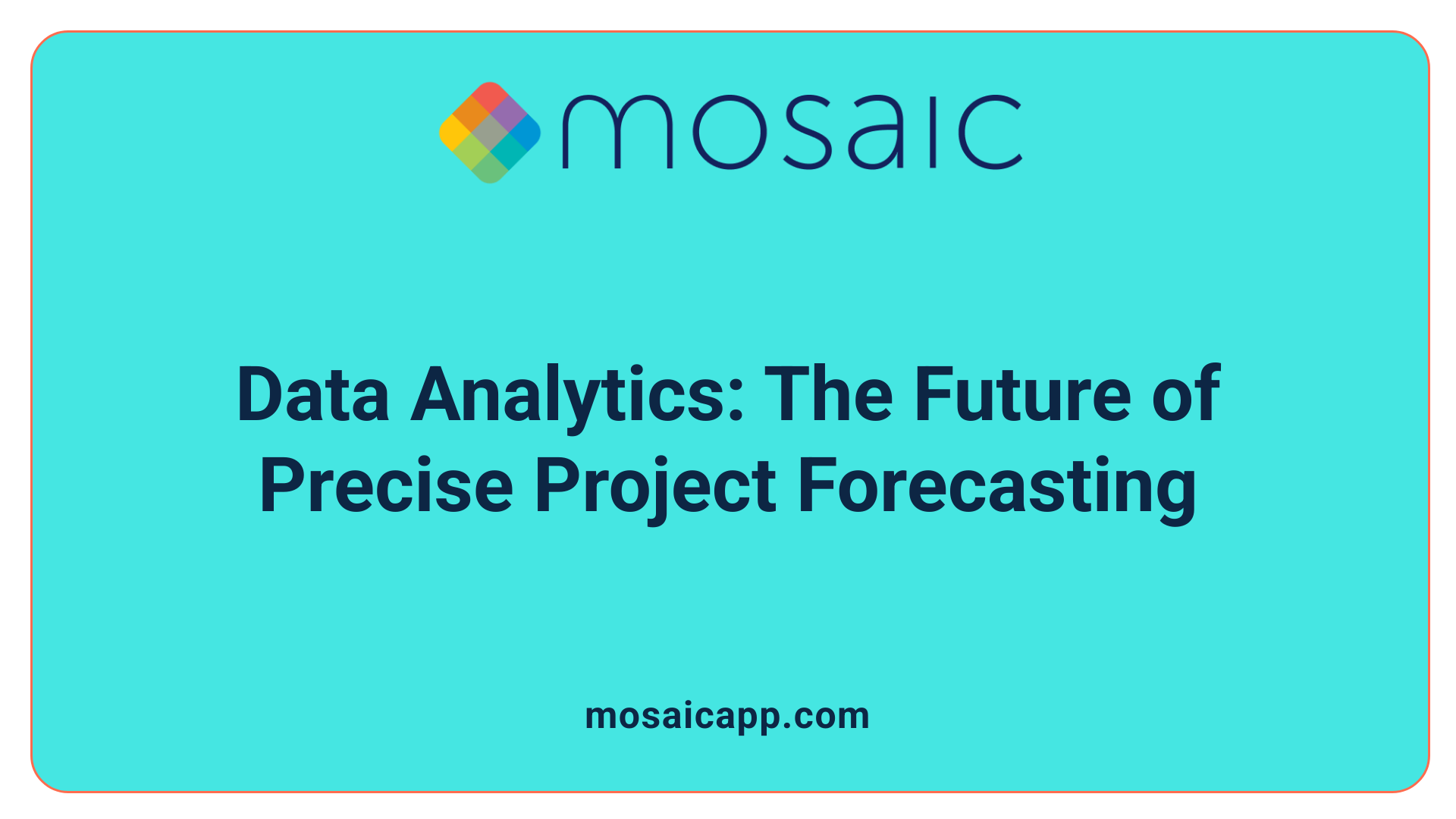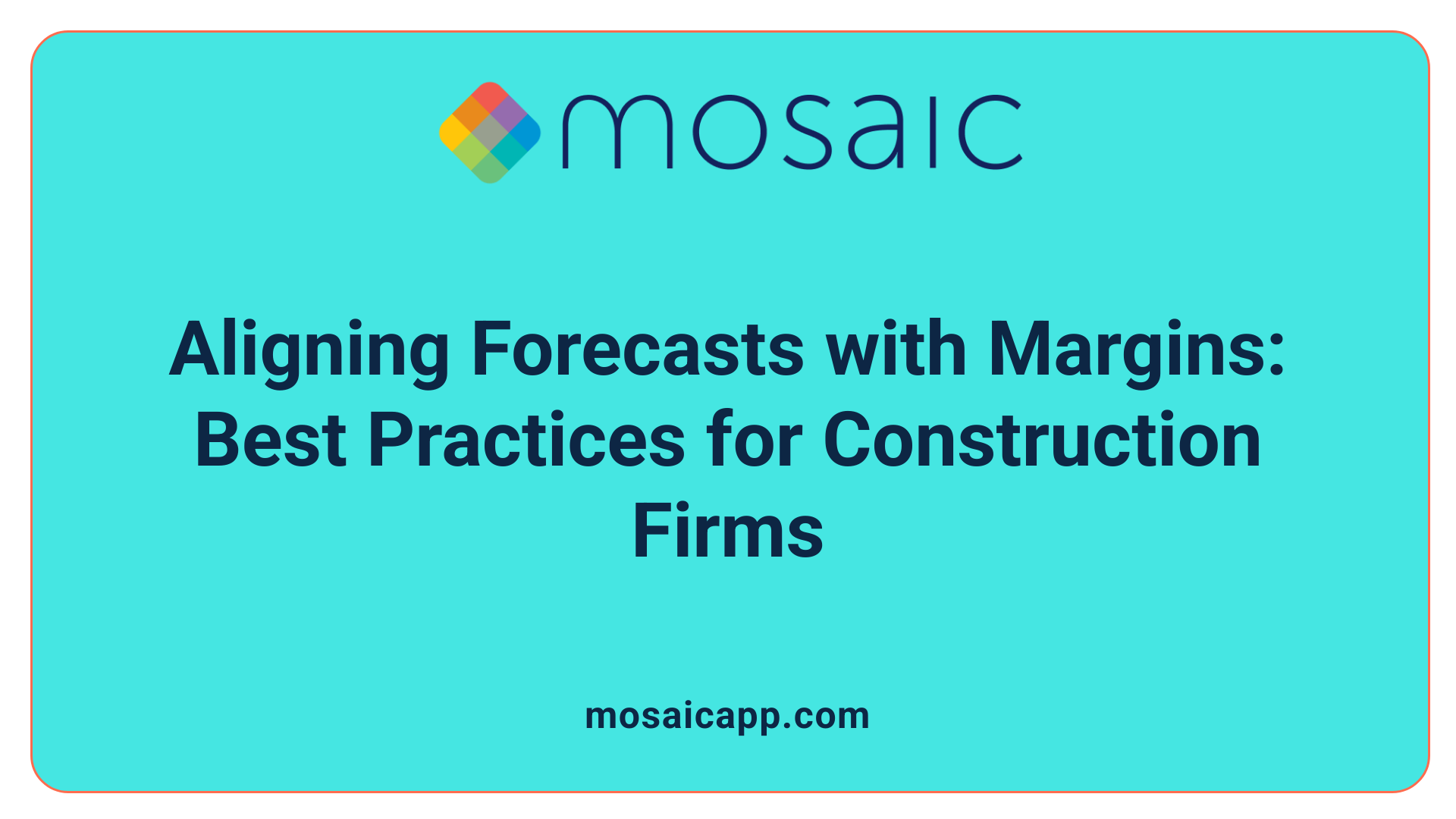Introduction: The Power of Accurate Forecasting in Construction Profitability
In today's volatile construction industry, the ability to accurately forecast project performance is no longer just a technical requirement but a strategic necessity. This article explores how project forecasting directly influences profit margins, the role of data analytics and advanced tools in enhancing forecast accuracy, and the best strategies for integrating these insights into margin management to foster sustainable growth.
Understanding the Strategic Importance of Project Forecasting

Why is project forecasting strategically important for business margin expansion?
Project forecasting plays a vital role in expanding profit margins within the construction industry. Accurate predictions of future financial performance enable organizations to better allocate resources and improve operational efficiency. By examining historical data, industry trends, and market indicators, companies can identify which projects are most profitable and highlight potential risks.
Effective forecasting informs critical decisions on pricing, cost management, and investments, ensuring that profit margins are maximized. It helps prevent costly overruns and delays, which are common pitfalls in construction projects. As market conditions change, regularly updated forecasts allow businesses to adapt quickly, maintaining their competitiveness.
Partnering with specialized providers or leveraging advanced software tools can enhance forecast accuracy. This strategic approach not only supports sustained margin growth but also fosters long-term success by aligning operational activities with financial goals.
How does accurate project forecasting influence profit margins?
Precise forecasting directly impacts a company’s ability to maintain healthy profit margins. When organizations accurately predict project costs and revenues, they can implement tighter cost controls and allocate resources more effectively.
Early identification of financial risks allows for timely adjustments, reducing the chance of profit erosion. Accurate forecasts also improve bidding strategies, positioning companies to capitalize on lucrative market opportunities.
The integration of automation, AI, and data analytics tools enhances forecast reliability by minimizing human errors and ensuring data consistency. Such technology-driven insights foster trust among stakeholders, support better financial planning, and facilitate sustainable profit growth.
The role of data and analytics in project forecast accuracy
Construction projects produce a vast array of data—from initial planning through project delivery—that can enhance forecast precision. Advanced data analytics enables companies to analyze profitability patterns across various project types, geographical locations, and time periods.
Big Data architectures and machine learning models help uncover hidden relationships between project attributes and profitability outcomes. These insights support more accurate margin predictions and strategic decision-making.
Furthermore, scenario planning and sensitivity analysis prepare firms for potential uncertainties, aiding proactive management of risks and maximizing opportunities.
The impact of poor forecasting on construction margins
When project forecasts are outdated or inaccurate, companies face several risks that can erode margins. Underbidding due to outdated cost data, internal price wars caused by lack of visibility, and delays in quote turnaround all reduce overall profitability.
Lack of centralized data on win/loss performance hampers strategic learning, preventing firms from improving their bidding and operational strategies. Moreover, poor demand visibility and forecasting hinder efficient planning, often resulting in overstocking or unprofitable work.
To combat these issues, construction firms are adopting data-driven approaches, integrating dashboards and analytics platforms to gain a holistic view of their projects, resources, and market conditions.
Strategies for effective project margin management
Effective margin management involves several strategic practices:
- Prioritizing high-margin projects based on data insights.
- Ensuring proper resource utilization to avoid wastage.
- Managing project scope carefully to prevent scope creep.
- Using regular performance reviews to compare actual margins against forecasts.
- Updating resource and cost plans weekly to reflect current realities.
Applying these strategies, supported by robust data analysis, helps firms optimize their project profitability.
Visual Summary of Construction Project Analytics and Margin Strategies
| Aspect | Description | Tools/Methods |
|---|---|---|
| Data Collection | Gather real-time, accurate project data | Internal systems, external market data |
| Data Analysis | Identify patterns and outliers | Exploratory Data Analysis, dashboards |
| Forecasting Models | Predict future margins and risks | Time series, regression, machine learning |
| Performance Monitoring | Track actual vs forecasted margins | KPI dashboards, weekly reviews |
| Risk and Scenario Analysis | Prepare for uncertainties | Sensitivity analysis, scenario planning |
| Margin Optimization Strategies | Improve profitability through targeted actions | Cost management, value-based pricing, efficiency measures |
Additional Factors Impacting Project Margins
Various factors, including oversight, resource planning, and customer service levels, influence project profitability. Ensuring transparent communication across teams and aligning project scopes with strategic goals are essential.
In conclusion, embedding data-driven decision-making into project planning and execution is crucial for improving margins. Real-time analytics, combined with well-defined strategies and continuous monitoring, empower construction firms to adapt quickly and maximize profitability in a competitive landscape.
Data Analytics: Transforming Forecast Accuracy and Profitability

How can data analytics improve project forecast accuracy and profitability?
Improving the accuracy of project forecasts and boosting profitability is essential for success in the competitive construction industry. Data analytics plays a vital role in this process by combining multiple sources of information—such as Building Information Modeling (BIM), Internet of Things (IoT) sensors, and project management software—to create a comprehensive view of project status and potential risks.
One of the greatest strengths of data analytics is its ability to provide real-time insights through dashboards and visualization tools. These allow project managers and stakeholders to monitor key performance indicators, detect emerging issues, and respond swiftly. For example, heat maps can highlight areas where costs are exceeding estimates or where delays are likely, enabling proactive adjustments.
Predictive analytics and machine learning models are particularly effective in identifying trends and future risks. These techniques analyze historical project data to forecast outcomes such as profit margins, resource needs, and schedule risks. This predictive capability helps teams make informed decisions, avoid costly overruns, and select more profitable projects.
Automated reporting and cloud-based platforms further enhance project management by enabling seamless data sharing across teams. This facilitates a collaborative environment where information is transparent and accessible from anywhere, ensuring alignment and faster decision-making.
Additionally, advanced data analysis helps optimize resource utilization, manage scope creep, and implement value-based pricing strategies. Continuous monitoring and regular updates, driven by high-quality data, ensure forecasts stay relevant amid changing market conditions.
Implementing these data-driven practices results in better control over project costs and timelines, improved risk management, and ultimately, higher project success rates. When decisions are backed by comprehensive, real-time data, construction firms can strategically allocate resources and seize profitable opportunities more effectively.
| Aspect | Description | Benefits |
|---|---|---|
| Data Integration | Combines BIM, IoT, project management software | More complete project picture |
| Predictive Analytics | Uses machine learning for forecasting risks | Proactive risk mitigation |
| Visualization Tools | Dashboards, heat maps, graphs | Quick understanding of complex data |
| Cloud Platforms | Automated reporting, collaboration tools | Seamless data sharing and updates |
| Continuous Monitoring | Real-time tracking of project metrics | Faster response to issues |
These integrations and technological advances foster a more agile, informed, and strategic approach to project management, significantly improving financial outcomes.
Tools and Techniques Elevating Forecast Precision and Profitability

What tools and techniques can enhance project forecast accuracy and profitability?
Improving the precision of project forecasts in the construction industry is vital for maximizing profitability and gaining competitive advantage. A blend of quantitative and qualitative methods forms the foundation of robust forecasting processes.
On the quantitative side, advanced analytical techniques such as time series analysis—like exponential smoothing or ARIMA models—are used to identify trends and cyclic patterns in historical data. These help estimate future project outcomes more reliably. Causal models, including regression and econometric techniques, analyze relationships between project variables like costs, timelines, and market conditions, allowing for more accurate demand and margin forecasts.
Simulation methods are also instrumental, with Monte Carlo simulations allowing project managers to assess risks by modeling various uncertainty scenarios. These probabilistic tools help predict a range of potential outcomes, enabling better contingency planning.
Qualitative approaches complement the numbers by incorporating expert judgment, industry insights, and market research. Techniques such as the Delphi Method gather consensus from experienced professionals to guide decision-making, especially when facing uncertain or unprecedented project conditions.
Modern project management systems play a pivotal role in refining forecasts through real-time analytics. Tools like earned value management (EVM) enable ongoing performance tracking, providing early warning signs of project deviations from original estimates. Incorporating real-time data dashboards and analytics platforms facilitates dynamic updates, helping teams adapt quickly to changing conditions.
Best practices also emphasize collaboration among stakeholders, transparency in data sharing, and iterative forecast reviews. Leveraging historical project data—both internal records and market benchmarks—allows continuous improvement of the forecasting process, helping firms fine-tune strategies and optimize margins.
In summary, combining these advanced tools with structured processes ensures more accurate forecasts, reduces risks, and leads to better project profitability.
Method Comparison Table
| Technique | Description | Use Case | Additional Details |
|---|---|---|---|
| Time Series Analysis | Identifies trends and seasonality | Forecasting costs and revenues | Includes models like ARIMA, exponential smoothing |
| Regression Analysis | Defines relationships between variables | Demand prediction, cost drivers | Includes multiple regressors and econometric models |
| Monte Carlo Simulation | Probabilistic risk assessment | Uncertainty and scenario planning | Runs numerous simulations to assess risks |
| Delphi Technique | Expert consensus method | New market insight, project risks | Gathers anonymous expert opinions over multiple rounds |
| Earned Value Management | Project performance tracking | Cost control, schedule adherence | Integrates scope, schedule, and cost data |
Factors for Forecast Success
| Aspect | Key Principle | Effect on Forecasting | Example |
|---|---|---|---|
| Data Quality | Accurate and relevant data | Improves predictive accuracy | Regular data validation |
| Stakeholder Engagement | Inclusive decision processes | Ensures forecast realism | Cross-team collaboration |
| Continuous Refinement | Regular updates and reviews | Maintains forecast relevance | Weekly scope and resource updates |
| Scenario Planning | Preparing for uncertainties | Strengthens risk mitigation | What-if analysis for market shifts |
Utilizing these techniques effectively involves integrating them into a comprehensive forecasting strategy that adapts to project and industry changes. Enables firms not only to predict outcomes more accurately but also to make smarter decisions that enhance profitability and project success.
Aligning Forecasting with Margin Management: Best Practices

How can construction companies better align forecasting efforts with margin management?
Achieving a seamless integration between forecasting and margin control requires a collaborative approach that bridges different departments like sales, finance, and operations. When these teams work together with shared goals, they can develop more accurate predictions of project profitability.
One effective strategy is to utilize predictive modeling and advanced analytics. These tools analyze historical data, market trends, and project-specific variables to forecast future costs and revenues more precisely. This deeper insight helps in identifying potential margin risks early and adjusting strategies accordingly.
Consistency in communication and review processes is crucial. Regular meetings and transparent sharing of forecast updates ensure that all teams stay aligned and can respond to real-time market dynamics. These review sessions help in revising estimates, managing scope changes, and optimizing resource utilization as projects progress.
Implementing real-time dashboards and automated monitoring solutions enables ongoing oversight of margin performance. These tools provide instant visibility into how current project margins compare to forecasts, allowing managers to take swift corrective actions to stay on target.
A company’s culture also plays a vital role. Promoting continuous learning, data-driven decision-making, and openness to feedback ensures that forecasting methods evolve with changing market conditions. Additionally, investing in staff training on the latest analytical techniques can significantly enhance forecast accuracy.
Overall, aligning forecasting with margin management fosters proactive decision-making, reduces financial risks, and enhances profitability across projects.
What strategies and best practices can help integrate forecasting with margin management?
To effectively integrate forecasting with margin management, organizations should adopt a cross-functional approach that aligns sales, finance, and operations teams around shared goals. Utilizing advanced analytics and predictive modeling can improve forecast accuracy and provide deeper insights into cost drivers and pricing strategies that impact margins. Establishing consistent communication channels and collaborative review sessions ensures that forecasts are adjusted proactively in response to market changes and performance discrepancies. Implementing automated tools and dashboards allows real-time monitoring of margin performance against forecasts, facilitating swift corrective actions. Ultimately, fostering a culture of continuous improvement and data-driven decision-making helps sustain alignment between forecast accuracy and margin optimization.
Transforming Forecasting from a Tactical Tool to a Strategic Asset
Why is project forecasting strategically important for business margin expansion?
Effective project forecasting is vital for expanding profit margins within the construction industry. It allows companies to accurately predict future financial results, which in turn supports smarter resource allocation and operational efficiency. By analyzing data from previous projects, market trends, and economic conditions, organizations can identify lucrative opportunities and avoid potential losses.
Accurate forecasts guide critical decisions such as setting competitive yet profitable pricing, managing costs, and prioritizing investments. This proactive approach helps firms optimize their margins over time. Furthermore, regularly updating these forecasts ensures that the business remains agile and responsive to industry changes, market fluctuations, and unforeseen challenges.
Partnering with technology providers and leveraging advanced data analytics tools enhances forecast accuracy. These collaborations can incorporate vast amounts of project data, facilitating deeper insights into profitability patterns and risk factors. As a result, organizations can sustain margin growth, improve strategic planning, and strengthen overall market competitiveness.
Use of scenario planning and sensitivity analysis
Scenario planning and sensitivity analysis are powerful tools that add an extra layer of foresight to project forecasting. Scenario planning involves creating multiple plausible future states based on varying assumptions such as material costs, labor availability, and market demand.
This method allows businesses to evaluate how different factors could impact project profitability. For example, analyzing best-case, worst-case, and most-likely scenarios helps organizations prepare for potential disruptions and identify contingency strategies. Sensitivity analysis complements this by showing which variables have the most influence on margins, guiding focus toward managing critical risks.
Incorporating these techniques into forecasting models enables companies to anticipate uncertainties and adapt their strategies dynamically. This proactive stance supports maintaining healthy margins even amid volatile conditions.
Regular updates for agility and responsiveness
The construction industry’s fast-paced nature demands that project forecasts be kept current. Regular updates—weekly or even daily—are essential to reflect actual project performance, market shifts, and new data insights.
Frequent revisions allow project teams to identify emerging issues early, such as scope creep, cost overruns, or resource shortages. Adjusting forecasts accordingly supports timely decision-making, such as reallocating resources or renegotiating contracts.
This continual feedback loop enhances a company's ability to respond swiftly to changes, minimizing risks to profit margins. It also fosters a culture of data-driven decision-making, which is crucial for maintaining competitiveness and achieving long-term financial goals.
Partnering with technology providers
Harnessing advanced technology solutions is fundamental to transforming forecasting into a strategic resource. Collaborations with software developers specializing in Big Data and analytics provide access to sophisticated tools for data collection, storage, and analysis.
These platforms can process large datasets spanning project parameters, market conditions, and economic indicators, revealing hidden patterns and predictive insights. Incorporating machine learning algorithms further refines margin predictions and scenario analyses.
Partnering with technology providers ensures organizations stay at the forefront of innovation, enabling continuous improvement in forecast accuracy. This technological edge supports strategic planning, risk mitigation, and long-term profit growth.
| Aspect | Description | Additional Details |
|---|---|---|
| Data Sources | Internal and external data are critical for accurate forecasting | Includes project costs, market trends, economic indicators |
| Analytical Tools | Use of statistical models, machine learning, scenario analysis | Enhances prediction accuracy and strategic insights |
| Forecast Update Frequency | Regular updates (weekly/daily) | Keeps forecasts relevant and actionable |
| Strategic Focus | Transition from tactical to strategic forecasting | Aims for long-term profit optimization |
| Innovation | Collaboration with tech providers | Leverages cutting-edge tools and expertise |
This comprehensive approach underscores the importance of evolving project forecasting from a reactive task to an integral part of strategic business management, ultimately driving sustainable profit growth.
Achieving Continuous Improvement for Margins and Forecasts
How does continuous monitoring and improvement influence margin growth?
In the competitive construction industry, ongoing evaluation of project performance plays a crucial role in boosting profit margins. Continuous monitoring involves regularly comparing actual project outcomes against initial estimates and forecasts. This practice helps identify deviations early, allowing teams to implement corrective measures swiftly.
By leveraging real-time data and market insights, organizations can adapt their strategies to changing conditions. For example, if material costs escalate unexpectedly, firms with up-to-date data can adjust pricing or sourcing strategies promptly. Such agility prevents margin erosion caused by unforeseen expenses.
Furthermore, integrating new technological tools, like advanced analytics and machine learning, refines forecasting models over time. These models incorporate historical project data, market trends, and operational variables, enhancing their predictive accuracy.
Fostering a culture that values continuous improvement encourages teams across departments to stay proactive. Regular reviews and performance metrics motivate problem-solving and process optimizations.
This iterative approach ensures that organizations not only recover from setbacks but also identify new opportunities for profit enhancement. By continuously fine-tuning their processes and forecasts, companies can sustain higher margins and maintain a competitive edge.
Market trend adaptation and its impact on project margins
Staying aligned with evolving market dynamics is essential for safeguarding and increasing project profitability. The construction industry is subject to fluctuations in material costs, labor availability, and regulatory changes.
Utilizing comprehensive data analysis allows organizations to monitor market trends closely. When these trends signal upcoming changes, adapting strategies—such as adjusting bids, sourcing materials differently, or shifting project timelines—becomes possible.
Predictive analytics can forecast future market shifts, enabling firms to proactively plan their resource allocation and pricing models. This foresight helps avoid over-committing or under-pricing, which can harm margins.
Regularly updating forecasts with the latest data ensures estimates remain relevant. This process reduces the risk of margin squeeze due to outdated assumptions and helps lock in profitability even amidst volatility.
Building a culture of innovation and continuous improvement
To embed continuous enhancement in margins and forecasting, fostering an organizational culture that prioritizes innovation is vital. Encouraging open communication, cross-team collaboration, and knowledge sharing creates an environment where new ideas and practices can thrive.
Providing ongoing training on the latest data analysis tools, market intelligence, and project management techniques equips teams to operate more effectively.
Implementing feedback loops, where project insights inform future bidding strategies and operational decisions, promotes a learning mindset.
Recognition programs that reward innovative problem-solving motivate employees to seek better ways of managing costs, schedules, and client relationships.
Ultimately, a culture embracing continuous improvement and innovation drives long-term profitability, resilience, and market responsiveness.
| Aspect | Description | Example |
|---|---|---|
| Performance Monitoring | Regular tracking and comparison of actuals to forecasts | Weekly review of project margins |
| Market Trend Adaptation | Adjusting strategies based on market signals | Changing sourcing based on material cost forecasts |
| Culture of Innovation | Promoting ongoing learning and improvement | Cross-department brainstorming sessions |
Table of construction margin improvement strategies and practices
This approach ensures an ongoing cycle of assessment, learning, and adaptation. Organizations that harness data-driven insights and foster a proactive culture are better positioned to optimize project margins consistently and sustain growth amidst market complexities.
Final Thoughts: Building Profitability Through Accurate Forecasting and Strategic Adaptation
In conclusion, the intricate relationship between project forecasting and profit margins underscores the importance of comprehensive data analysis, advanced predictive tools, and strategic integration. By adopting a data-driven approach and fostering cross-functional collaboration, construction firms can mitigate risks, capitalize on opportunities, and enhance profitability. Continuous improvement and technological innovation are key to maintaining forecasting accuracy and margin health, ultimately driving sustained business growth in a competitive industry. A focus on strategic forecasting not only ensures operational agility but also establishes a resilient foundation for long-term success.
References
- 5 Hidden Issues That are Killing Your Profit Margins as a ...
- Investigating profitability performance of construction ...
- How to Forecast and Plan Your Future Margin Performance
- How to Calculate, Track and Forecast Project Margin for ...
- Maximize Profits: Strategic Financial Forecasting for SMBs
- Profitability Forecasts: What They Are and How to Create ...
- 7 Financial Forecasting Methods to Predict Business ...
- The Power of Financial Forecasting for Business Success ...
- Project Forecasting: The Ultimate Guide for Successful ...


